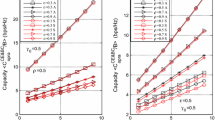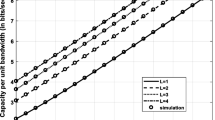Abstract
In this paper the performance of predetection maximal ratio and equal gain combiners are investigated under conditions of correlated branch noise. A statistical model is devised to determine the spatial noise correlation coefficients at metropolitan‐area base stations, and the cases where significant correlation is likely are clarified. Optimal weighting coefficients for a maximal ratio combiner with two‐branch space diversity are derived under correlated noise. Based on this result it is shown that correlation in branch noise can be used to improve the combiner performance by dynamically adjusting the weightings so as to partially cancel the noise. Performance of equal gain combiners is also shortly discussed.
Similar content being viewed by others
References
D.G. Brennan, Linear diversity combining techniques, Proceedings of IRE 47 (1959) 1075–1102.
J.M. Franklin, Matrix Theory (Prentice-Hall, Englewood Cliffs, NJ, 1968).
N.T. Gaarder, Maximal ratio diversity combiners, IEEE Transactions on Communications Technology 15 (1967) 790–797.
M.J. Gans, The effect of Gaussian error in maximal ratio combiners, IEEE Transactions on Communication Technology 19 (1971) 492–500.
W.C. Jakes, Microwave Mobile Communications (Wiley, New York, 1974).
N.L. Johnson and S. Kotz, Distributions in Statistics, Vol. 2 (Wiley, New York, 1972).
M. Kalkan, Transmitter diversity, modulation and transmission-rate allocation techniques for mobile and portable radio systems, Ph.D. thesis, Imperial College of Science, Technology and Medicine, London (1992).
W.C. Lee, Antenna spacing requirement for a mobile radio base-station diversity, The Bell System Technical Journal 50 (1971) 1859–1876.
W.C.Y. Lee, Mobile radio performance for a two-branch equal-gain combining receiver with correlated signals at the land site, IEEE Transactions on Vehicular Technology 27 (1978) 239–243.
W.C.Y. Lee, Mobile Communications Engineering (McGraw-Hill, New York, 1982).
W.C.Y. Lee, Mobile Communications Design Fundamentals (Howard W. Sams, Indianapolis, 1986).
W.C.Y. Lee, Mobile Cellular Communication Systems (McGraw-Hill, New York, 1989).
A. Papoulis, Probability, Random Variables and Stochastic Processes (McGraw-Hill, Auckland, 1984).
J.D. Parsons and J.G. Gardiner, Mobile Communication Systems (Blackie, London, 1989).
M. Schwartz, W.R. Bennett and S. Stein, Communication Systems and Techniques (McGraw-Hill, New York, 1966).
E.N. Skomal, Man-Made Radio Noise (Van Nostrand Reinhold, New York, 1978).
Author information
Authors and Affiliations
Rights and permissions
About this article
Cite this article
Kalkan, M., Kerestecioğlu, F. Optimal diversity combining under correlated noise in mobile radio. Telecommunication Systems 8, 303–317 (1997). https://doi.org/10.1023/A:1019173807302
Issue Date:
DOI: https://doi.org/10.1023/A:1019173807302




